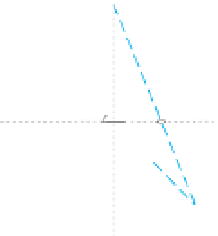Geoscience Reference
In-Depth Information
that this is not the case. Even after careful analysis, esti-
mating a representative remanent magnetism for a unit is
extremely dif
cult. More measurements than can be justi-
fied economically are virtually always required. As with
susceptibilities, the practical solution is to identify likely
ranges in directions and intensities, which may vary from
area to area, and use these as a basis for interpreting
magnetic responses.
a)
Upper hemisphere
projection
-45°
+45°
P
P
Lower hemisphere
projection
Inc = -45°, Dec = 0°
Inc = +45°, Dec = 0°
b)
c)
NW
SE
NW
SE
3.9.9
Correlations between density
and magnetism
Gravity and magnetic data are often used together for
geological mapping and target identification. However, it
must be stressed that there is no physical reason why the
density and magnetism of a rock formation, and indeed
variations in these properties, must be related. Recall that
magnetism depends primarily on the content of what is
usually an accessory mineral; whereas, in contrast, density
is a bulk property of the rocks re
ecting their matrix
mineralogy and, in the presence of signi
cant porosity,
the pore volume and contents as well. Consequently, grav-
ity and magnetic maps re
ect fundamentally different
physical characteristics of the rocks, so they may differ
signi
cantly.
For some rock types, density and magnetism roughly
correlate because the variation in magnetite content cor-
relates with felsicity, which in turn controls the proportion
of the denser mafic minerals. So correlations may occur in
crystalline rocks, but are less likely in sedimentary rocks
where magnetism is generally very weak and density is
describes the correlation between magnetism and density
of crystalline lithotypes in the Baltic Shield. In a plot of
density versus magnetic susceptibility, most of the data
plot in one of two
fields, termed the paramagnetic and
magnetite trends by Henkel (
1991
)
(
Fig. 3.63a
). Within
each
field there is some correlation between density and
susceptibility, although it is weak compared with the effects
of geological processes that tend to change (usually) mag-
netite content and cause lithotypes to move from one
eld
to the other, or to some intermediate position as with
metamorphism and serpentinisation. Serpentinisation is a
very signi
cant factor because of the large associated
reduction in density and increase in magnetism (
Figs. 3.34
and
3.52
), and the breaking of the general observation that
density and magnetism often increase together.
N
N
Magnetic vectors
Negative inclination
Positive inclination
Figure 3.62
Measuring the direction of remanent magnetism. (a)
Upper and lower hemisphere stereographic projections, as needed, to
account for the possibility of positive or negative magnetic
inclinations. Directions of remanent magnetism formed (b) before
and (c) after a folding event, and their appearances on a
stereographic projection.
directions; negative inclinations must be projected from
the upper hemisphere. Magnetic directions of
45° (Inc)
and 0° (Dec), and +45° (Inc) and 0° (Dec), will plot at the
same point on the stereo net (
Fig. 3.62a
). They are distin-
guished by using different symbols for positive and nega-
tive inclinations.
The directions of individual components, and therefore
the NRM itself, can vary across an area of interest. For
example, a remanent magnetism that precedes a folding
event will have a consistent direction relative to the bed-
ding plane but will vary across a fold in the same way as the
dip of the bedding (
Fig. 3.62b
). If the direction of the
remanent magnetism is post-folding its direction is
unaffected by the fold but varies relative to the bedding
plane (
Fig. 3.62c
)
. The result is that the magnetic anomaly
produced by similar geology will be signi
cantly different.
In practice remanent magnetism is either ignored or
assumed to be parallel to the induced magnetism, unless
magnetic anomalies have characteristics that demonstrate
-

























































































Search WWH ::

Custom Search